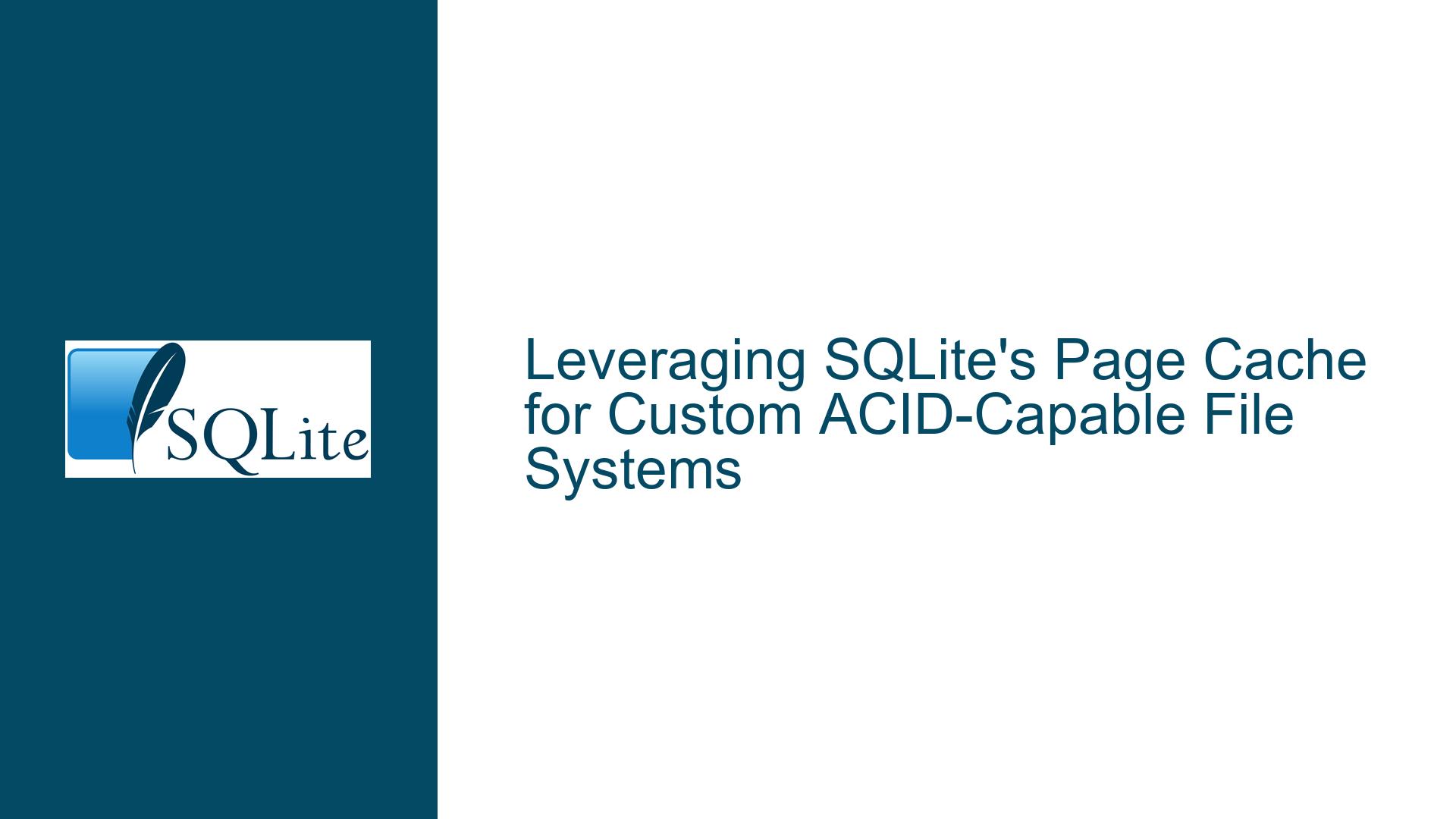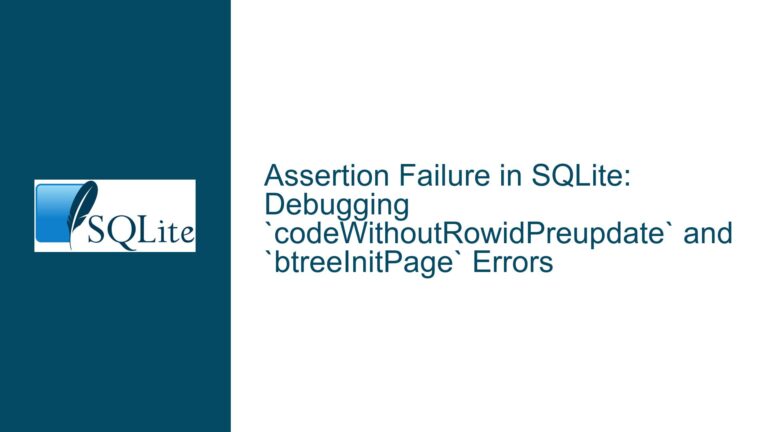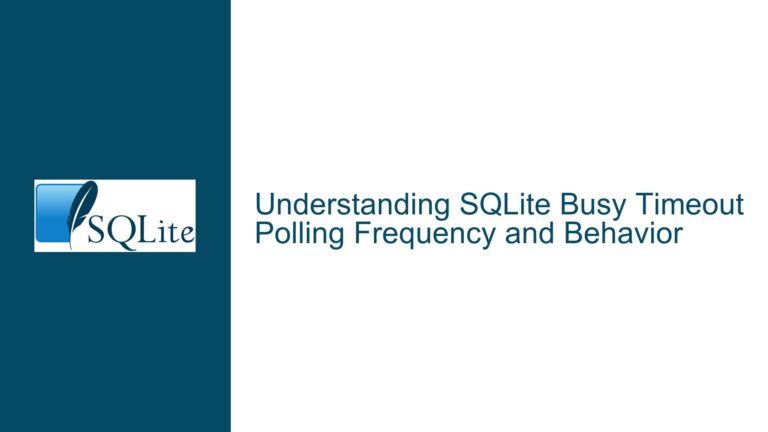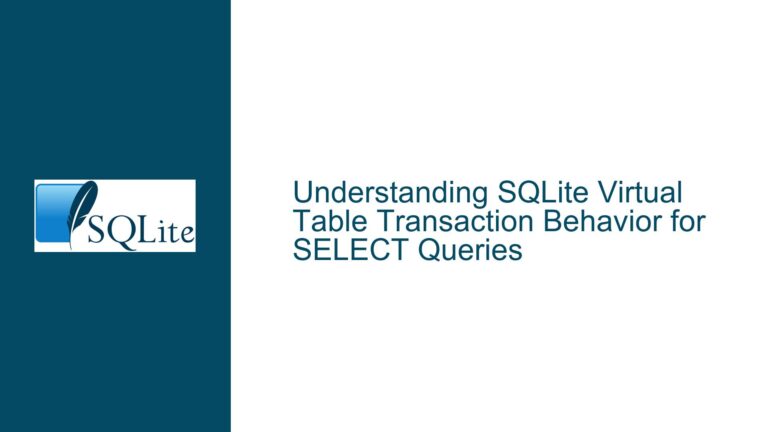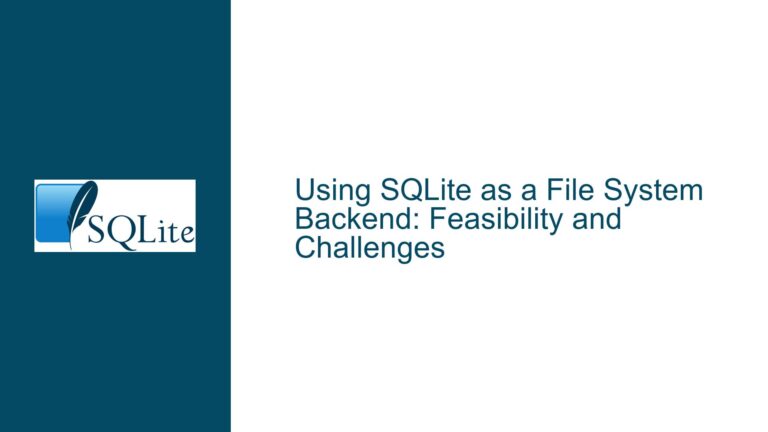Leveraging SQLite’s Page Cache for Custom ACID-Capable File Systems
Understanding SQLite’s Page Cache Subsystem and Its Role in ACID Compliance
SQLite’s page cache subsystem (referred to as the "pager") is a critical component responsible for managing disk I/O, transaction atomicity, and concurrency control. It operates at a lower level than the SQL engine or B-Tree layer, handling the mechanics of reading and writing database pages to disk while ensuring durability and consistency. The pager interacts with the operating system’s file APIs through the Virtual File System (VFS) layer, which abstracts platform-specific details. ACID guarantees in SQLite are achieved through a combination of the pager’s write-ahead logging (WAL), rollback journals, and strict locking protocols.
However, the pager does not function in isolation. It relies on coordination with higher-level subsystems such as the B-Tree module, which manages data organization, and the SQL core, which orchestrates transactions. For example, when a transaction commits, the B-Tree layer signals the pager to flush dirty pages to disk and update the journal files. This interdependency complicates attempts to extract the pager for standalone use. The pager assumes the presence of a structured storage format (e.g., fixed-size pages, predefined header fields) and expects callers to enforce constraints like schema integrity. Attempting to repurpose it for a custom file format requires replicating these assumptions without the scaffolding provided by SQLite’s upper layers.
Key Obstacles to Decoupling the Page Cache from SQLite’s Architecture
Tight Coupling with the B-Tree and Transaction Management Layers
The pager is designed to service SQLite’s B-Tree module, which manages index and table structures. The B-Tree invokes pager methods to fetch pages, mark them as dirty, and initiate checkpoints. Transaction boundaries (BEGIN, COMMIT, ROLLBACK) are enforced through a combination of pager-level locks and journaling mechanisms. For instance, when a write transaction starts, the pager acquires an exclusive lock on the database file and creates a rollback journal. Isolating the pager would necessitate reimplementing transaction lifecycle management, including lock acquisition, journal synchronization, and crash recovery—all of which are partially handled by the B-Tree and SQL layers in standard SQLite.
Dependency on SQLite’s Virtual File System (VFS) Abstraction
The pager delegates low-level file operations to the VFS layer, which handles platform-specific nuances like file locking, memory mapping, and atomic writes. While the VFS is theoretically replaceable, crafting a custom VFS that satisfies the pager’s expectations requires deep familiarity with SQLite’s internal invariants. For example, the pager assumes that the VFS can reliably enforce write-ordering and persist metadata such as the database size and change counters. Deviations from these expectations—such as using a non-file-based storage medium or a fragmented page layout—risk violating ACID guarantees.
Assumptions About Page Format and Schema Enforcement
SQLite’s pager operates on fixed-size pages (default: 4096 bytes) with a strict structure: each page includes a header for transaction IDs, checksums, and flags. The B-Tree layer further subdivides pages into cells and payloads, enforcing constraints like key ordering and overflow handling. A custom file format must either adhere to these conventions or extensively modify the pager to accommodate variable-sized pages, alternative checksumming algorithms, or non-B-Tree data models. Additionally, the pager lacks intrinsic knowledge of schema evolution; it depends on the SQL layer to manage ALTER TABLE operations and versioning.
Implementing ACID-Capable Storage Using SQLite Components: Approaches and Tradeoffs
Option 1: Utilize SQLite’s VFS Extension Mechanism
The most viable path to leveraging SQLite’s pager for custom storage is to implement a custom VFS that maps the pager’s file operations to your desired storage format. This approach is exemplified by the ZipVFS extension, which stores database pages within a ZIP archive while preserving ACID properties. By overriding VFS methods like xWrite, xRead, and xLock, you can interpose your own logic for serializing pages, handling concurrency, and managing journals. However, this still requires adherence to SQLite’s page format and transaction protocols. The pager will generate WAL files or rollback journals in the background, which your VFS must store alongside the primary data.
Example Workflow for a Custom VFS:
- Define a VFS implementation that translates pager requests (e.g., "write page 5") into operations on your storage medium.
- Handle journaling/WAL manually: If using WAL mode, your VFS must manage the WAL index and checkpointing process. For rollback journals, ensure atomic replacement of the main file with the journal on commit.
- Enforce locking semantics: Implement
xLockandxUnlockto prevent concurrent writes, even if your storage backend lacks native locking support.
Option 2: Fork and Modify SQLite’s Pager Subsystem
For scenarios requiring radical deviations from SQLite’s page format or transaction model, consider forking the SQLite source code and modifying the pager directly. This allows you to:
- Alter page headers to include custom metadata.
- Disable B-Tree integration by stubbing out calls to
sqlite3BtreeCommitorsqlite3BtreeRollback. - Introduce new journaling mechanisms tailored to your storage needs (e.g., appending deltas to a log-structured file).
However, this approach carries significant maintenance overhead. SQLite’s pager is tightly integrated with other subsystems, and changes to one component may necessitate updates across the codebase. Forks also lose the benefit of upstream bug fixes and optimizations.
Option 3: Leverage Existing SQLite Extensions (LSM, ZipVFS)
SQLite’s LSM1 extension provides a key-value store built atop a modified version of the pager, demonstrating how to bypass the SQL and B-Tree layers. While LSM1 is deprecated, its source code offers insights into isolating the pager. Similarly, ZipVFS illustrates how to layer ACID semantics atop non-database file formats. These extensions can serve as templates for custom implementations, though they may require adaptation to modern SQLite versions.
Critical Considerations:
- Testing and Verification: Any custom solution must replicate SQLite’s rigorous testing regimen, including crash simulation (e.g.,
pragma crash_on_commit) and checksum validation. - Performance Implications: Bypassing SQLite’s query optimizer and buffer pool may degrade throughput, especially for random access patterns.
- Legal and Licensing Constraints: Ensure compliance with SQLite’s license (public domain) when modifying or redistributing code.
In summary, while SQLite’s page cache subsystem is not designed for standalone use, determined developers can repurpose it by embracing its architectural constraints or investing in deep customization. The optimal strategy depends on the degree of control required over the storage format and the willingness to maintain a SQLite derivative. Alternatives like LMDB or BerkeleyDB offer embedded ACID key-value stores but lack SQLite’s battle-tested resilience and portability.
